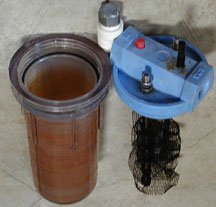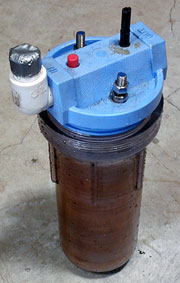|
Simple Wiring
One side (cathode) (-) is grounded to the car's frame the other (anode) is hooked up to a 25 amp fused thick wire (10-12 gauge braided copper wire, buy a spool at the auto parts store), 12 volts (+). I hooked up a simple auto accessory relay ($5.00) and a dash mounted switch ($5.00) What the relay does is, it allows the switch to get an 1 amp or so, current , while the relay turned on takes up to 25 amps coming straight form the battery (+). This way you can use a 5 amp rated cheap switch rather than a 25 amp switch. Remember the more amps the thicker the wires need to be. DC needs thick wires or you start to lose amperage. To have efficient egas, you only need 2 volts, the extra 10 volts does nothing but heat up your cell water. I'm no electronic wizard, so I left it simple. There are circuits on the egaspower yahoo group files. I say "join today and learn all you wanted to know about running a water powered car.
 Photo of the DC pulsed motor Controller
Photo of the DC pulsed motor Controller |
DC pulsed motor Controller
A simple solder kit for $14.95 plus .99 shipping. It can take 12 volts up to 25 amps, it has a 555 mosfet that pulses the signal much like AC does already. The pulsing action at the right frequency (about 8, on a pot. 1-10) helps in more egas production. The Hydro Booster will work without it, but to add more egas what the hay. You hook up a Pot, to the circuit and you dial it in till it bubbles the most. This is why clear filter housing is good for experimenting, because you can watch the bubble action and show friends. They won't last forever, much like SS 4" pipe would be best for long time applications.
Another DC Motor Controller source.
|
 Photo of the New Hydro-Booster hooked up. Photo of the New Hydro-Booster hooked up. |
 I have a one way check value, so engine by gasses will not come back into unit. So guys complain about backfire, I never encounter backfiring. I have it hooked to the vacuum in at idling and also to the throat of the carb.
I have a one way check value, so engine by gasses will not come back into unit. So guys complain about backfire, I never encounter backfiring. I have it hooked to the vacuum in at idling and also to the throat of the carb. |
|
Recently Peter added this Brawny Hydro-boost to the egaspower group. He says we all make Baby boosters. If you really want to get great gas mileage, try adding a 1/4" steel line or 3/8 soft copper, from a hole you drill into your exhaust pipe before the converter, and weld in place, or place treaded Jerry rig fitting. Have the air line go into your cell at the bottom so it helps push the egas through to your fuel source. Put a value on the air in, so you can play around with little or alot of bubble action. It's funny to watch, don't blow up. I also will remember the time at the Hwy rest area, during the hot summer on a road trip, I had a distilled water in a clear whiskey bottle., Stopped at a rest area with the hood up filling the cell with water and a black brother walks up and says "what the hell you got there son, feeding your truck old bourbon whiskey, his eyes were wide up and looking and we both could not stop laughing, explaining him the device later, at first I went along with I'm trying to get the old rig drunk I said. He s really thought I was burning grain alcohol in my truck! Then my friend walks up and explains it's only water.
The brawny booster works good so far. I have not checked my mileage lately. You can also install a MAP sensor potimeter and adjust down your air to fuel ratio (14.7 to 1) to (14.7 to 100:1) by turning a dial.
Bypass your oxy. sensor too. Don't try it at home. You can buy the plans here, but not from me. I don't sell anything yet, or may never.
I'm just handing out the hints to be a successful happy fuel saver.
Now the Electrolyte
It's not a atomic separator/fuel cell, it's just a battery.
You got it all installed. With the filter housing you can use 4" 3/8" 'U' bolts from any hardware store. I made a 1/8" steel plate holder. MacGiver it baby. Gerry Rig helped me. See photo above. I use 12 volts with 25 amp fuses as to not burn up my DC pulsar. Peter has 80 amp fuses? Sounds like a breaker box fuse? He uses 2 volts at 70 amps or more. Fill the unit with rainwater or any water, some use distilled, it does not matter, you will be taking it out to clean it up, once your amps go down. Fill up to the top of the switch plates with water and 1-3% KOH (Potassium Hydroxide) from a chemical supply house. You will pay more for hazardous shipping than you will for the chemical. We found this is the best electrolyte, it is a base, rather than an acid. Sulfuric acid works but corrodes things faster. Lye works too, but puts off weird fumes and also attacks and melts some plastics. ALso once you get the unit going you never add electrolyte again until you clean it out. You just add water, because the electrolyte stays in the container and does not separate into H-O gas.
Next. Start the car and drive. A good way to check gas mileage is to fill your tank to the top (top it off) go drive around for a week and fill it up again to the top, at the same pump at the same gas station. So the car is level as the last fill up. Read the gas pump meter for gallons. And there you have it. Miles Per Gallon. Any questions?
|
Other links to more Hydro-boosters
HIMAC • Hydrogen-Boost • Better Mileage • The Water Fuel Cell • Eagle Research
The Best Water Group Files
Egaspower • Watercar • Waterfuel1978 • Radiant Energy
• WaterFuel Cell Research Group • OUPower •
CommuteFaster.com |



















